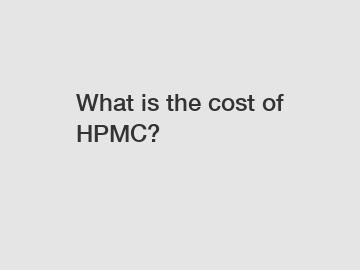What is the cost of HPMC?
Welcome to our blog discussing the cost of Hydroxypropyl Methylcellulose (HPMC). As a vital component in the pharmaceutical industry, HPMC is used in a wide range of applications, such as drug delivery systems, film coatings, and sustained-release formulations. In this article, we will explore the factors affecting the cost of HPMC, including its production process, market dynamics, and the added value it brings to pharmaceutical products.
Understanding HPMC.
Hydroxypropyl Methylcellulose, commonly known as HPMC, is a semi-synthetic, non-ionic, and water-soluble cellulose ether derived from naturally occurring cellulose. It is primarily derived from wood pulp or cotton fibers and is later subjected to chemical modifications. These alterations result in a highly versatile and multifunctional pharmaceutical ingredient that can be found under various tradenames in the market.

Factors Affecting HPMC Pricing.
1. Manufacturing Process and Purity Grades.
The production process of HPMC entails several steps, including etherification, purification, spray drying, and particle size control. The type and quality of the starting material, the purity grade required, the extent of etherification, and the control of impurities all play a significant role in determining the cost of HPMC. Higher purity grades usually command a higher price due to the extensive purification processes involved.
2. Supply and Demand Dynamics.
Similar to any raw material, the cost of HPMC is influenced by market forces, including supply and demand. Factors such as production capacity, global demand for pharmaceutical applications, and regional production variations can impact its price. Fluctuations in raw material availability, such as wood pulp and cotton fibers, can also influence the overall supply chain, thereby affecting the pricing of HPMC.
3. Research and Development Costs.
The development and continuous improvement of HPMC as a pharmaceutical ingredient require significant investment in research and development. These costs are often incorporated into the final price of HPMC products. Companies with a long-standing history of expertise in cellulose chemistry and pharmaceutical applications are likely to invest heavily in R&D to enhance HPMC's performance, resulting in higher market prices.
4. Regulatory Compliance and Quality Standards.
The pharmaceutical industry is highly regulated, and any ingredient used must comply with stringent quality standards. Manufacturers producing HPMC are expected to meet specific regulatory requirements, including Good Manufacturing Practices (GMP) and meet quality certifications such as ISO 9001. These compliance costs can contribute to the final price of HPMC.
The Value Proposition of HPMC.
As a versatile pharmaceutical ingredient, HPMC offers numerous benefits that outweigh its cost implications. Let us explore the added value it brings to pharmaceutical products:
1. Enhanced Drug Delivery Systems: HPMC acts as a controlled-release agent, enabling the gradual release of drugs over time. This property enhances bioavailability, reduces dosing frequency, and improves patient compliance.
2. Improved Stability and Solubility: HPMC enhances the stability of drugs, protecting them from degradation or reactivity with other ingredients. It also improves solubility, ensuring better dissolution rates and bioavailability.
3. Film Coating Advantages: HPMC provides a protective coating for tablets and capsules, improving their appearance, taste masking, and facilitating an easy swallowing experience. Additionally, it extends shelf-life by shielding against environmental factors such as moisture and light.
4. Versatility in Formulations: HPMC is compatible with a wide range of active pharmaceutical ingredients and excipients. Its ability to modify viscosity, act as a binder, and form gels make it suitable for various dosage forms, including oral solid dosage forms, ophthalmic solutions, and topical creams.
Conclusion.
In conclusion, the cost of HPMC is influenced by several factors, including the manufacturing process, supply-demand dynamics, research and development costs, and regulatory compliance. While the pricing may vary, the value proposition of HPMC justifies its use in pharmaceutical formulations. Through enhanced drug delivery systems, improved stability, versatility, and film coating advantages, HPMC offers significant benefits to both manufacturers and patients alike. By understanding the factors affecting its cost and appreciating its value, pharmaceutical companies can make informed decisions when incorporating HPMC into their formulations.
If you want to learn more, please visit our website water reducing agent in concrete, china hebei HPMC manufacture, construction fields HPMC.


